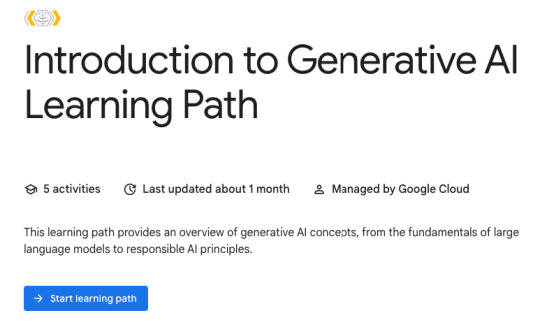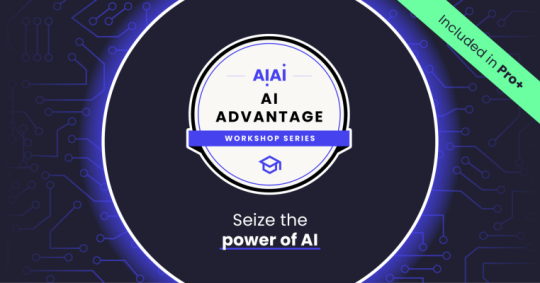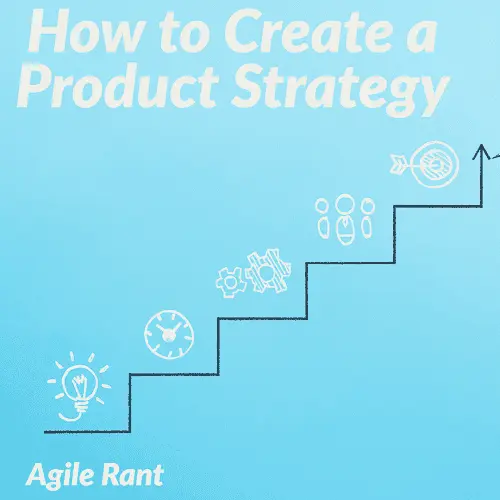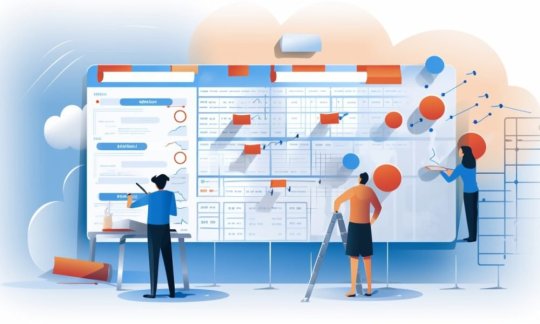#strategy:
Video
youtube
Hammer Time!
Madhog has played "Unicorn Overlord": https://twitter.com/AdrianoBordoni1/status/1766250049938292872
3 notes
·
View notes
Text
Top 10 free AI courses you need to know about
New Post has been published on https://thedigitalinsider.com/top-10-free-ai-courses-you-need-to-know-about/
Top 10 free AI courses you need to know about

Artificial intelligence (AI) is quickly becoming vital to countless aspects of life, and understanding its foundations, implications, and applications is more important than ever.
We had a look at the free AI courses being offered right now and came up with a list of free classes you can take to get you started on artificial intelligence or to complement your knowledge.
Featuring offerings from prestigious institutions and platforms like Google Cloud, Vanderbilt University, and the University of Helsinki, these courses cover a broad range of topics including generative AI, TensorFlow, ethical considerations, and practical applications in business and societal good.
In this article, we highlight the top 10 free AI courses you need to know about, such as:
Introduction to Generative AI Learning Path
Prompt Engineering for ChatGPT
AI For Business Specialization
AI Foundations for Everyone
Career Essentials in Generative AI by Microsoft and LinkedIn
AI for Everyone
An introduction to artificial intelligence
Intro to TensorFlow for Machine Learning
Ethics of AI
AI for Good Specialization

💰 Free
📖 5 activities
⏰ 7h30m
✅ Last updated a month ago (as of April 2024)
🧑💼 Managed by Google Cloud
🏫 Beginner level
This artificial intelligence course is offered by Google Cloud Skills Boost. This beginner microlearning course doesn’t need you to have any technical knowledge or background. It’s a great way of helping you learn generative artificial intelligence, including large language models (LLMs) and responsible AI principles.
It introduces Google’s seven AI principles and ends by explaining the practice of responsible AI in Google Cloud’s products, taking a comprehensive approach to educating learners about the current landscape of artificial intelligence.
The modules are:
Introduction to Generative AI
Introduction to Large Language Models
Introduction to Responsible AI
Prompt Design in Vertex AI
Responsible AI: Applying AI Principles with Google Cloud
📖 7 assignments
🎓 LinkedIn shareable certificate
⏰ 18h
🧑💼 Built by Vanderbilt University
🏫 Beginner level
Part of Vanderbilt University’s Prompt Engineering Specialization, this course is a self-paced artificial intelligence class designed to improve your prompt engineering skills. Composed of six modules, the course will build up your subject-matter expertise in ChatGPT and other language models.
You’ll be introduced to the patterns and approaches that will enable you to write effective prompts for these large language models. You’ll start with basic prompts and work your way to sophisticated prompts.
The course will allow you to apply your prompt skills and knowledge of LLMs for a wide range of tasks in your education, personal life, job, and more.
The modules are:
Course Introduction
Introduction to Prompts
Prompt Patterns I
Few-Shot Examples
Prompt Patterns II
Prompt Patterns III
Note: The graded assignments, shareable certificate, and feedback are paid.
📖 4-course series
🎓 LinkedIn shareable certificate
⏰ 1 month (at 10 hours a week)
🧑💼 Built by the University of Pennsylvania
🏫 Beginner level
This four-course series will provide you with the fundamentals of using artificial intelligence, machine learning, and with, teaching you how to apply them to support your business. Covering topics such as the risks of AI and ethics, people management in the fair design of human resources within machine learning, and designing governance frameworks to apply artificial intelligence fairly.
After taking this specialization, you’ll be able to implement ethical AI strategies and better understand the relationship between AI, machine learning, and data analytics. Each course ends with an assignment and two courses include peer-review exercises.
The courses are:
AI Fundamentals for Non-Data Scientists (7 hours)
AI Applications in Marketing and Finance (6 hours)
AI Applications in People Management (9 hours)
AI Strategy and Governance (9 hours)
📖 4-course series
🎓 LinkedIn shareable certificate
⏰ 1 month (at 10 hours a week)
✅ Last updated November 2023
🧑💼 Built by IBM
🏫 Beginner level
Built for beginners with little to no background in artificial intelligence, this specialization is a 4-course series designed to provide an understanding of what AI is, its applications, and use cases.
You’ll also learn about IBM Watson AI services and how to create intelligent virtual assistants and how these can be utilized in different applications. At the end of the specialization, you’ll have had hands-on interactions with a variety of AI environment applications, and will also have built and deployed an AI-enabled chatbot on a website without coding.
The courses are:
Introduction to Artificial Intelligence (AI) (8 hours)
Generative AI: Introduction and Applications (6 hours)
Generative AI: Prompt Engineering Basics (7 hours)
Building AI-Powered Chatbots Without Programming (12 hours)
📖 6-course series
🎓 LinkedIn shareable certificate from Microsoft
⏰ 4h30m
✅ Last updated a month ago (as of April 2024)
🧑💼 Built by Microsoft and LinkedIn
🏫 Introductory level
This course is made up of six different videos, each hosted by a different AI expert, covering a wide variety of topics and ethical considerations about AI models.
You’ll learn how to use Microsoft Copilot, including how to apply it to Word, how to analyze data in Excel, and more. The last video, “Introduction to Artificial Intelligence”, covers the best AI tools for businesses, which can be beneficial if you haven’t taken the plunge just yet.
The videos are:
What is Generative AI? (42 minutes)
Generative AI: The Evolution of Thoughtful Online Search (26 minutes)
Streamlining Your Work with Microsoft Copilot (34 minutes)
Learning Microsoft 365 Copilot (34 minutes)
Ethics in the Age of Generative AI (38 minutes)
Introduction to Artificial Intelligence (1h34m)
📖 1 course
⏰ 6h (4-week course)
🧑💼 Taught by Andrew Ng
🏫 Introductory level
Built to demystify artificial intelligence for non-technical business professionals, the course is taught by Andrew Ng, one of the most well-known names in artificial intelligence.
You’ll gain insights into AI’s workflow, strategy, terminology, and impact on society. The syllabus covers what AI and machine learning are, the workflow of ML and data science projects, how to incorporate AI into your company, and the societal implications of AI.
You’ll also learn how to build a sustainable AI strategy, making it ideal if you want to understand AI’s capabilities, limitations, and influence on various sectors.
The 4-week syllabus consists of:
Week 1: What is AI
Week 2: Building AI Projects
Week 3: AI in Your Company
Week 4: AI and Society
📖 2-week course
🎓 Free statement of participation on completion
⏰ 6h
🧑💼 Offered through The Open University’s “AI Matters” platform
🏫 Introductory level
The course explores the historical, ethical, and social aspects of AI. It’s designed to clarify AI’s opportunities and risks, focusing on how AI has evolved, its impact on society, and the ethical challenges of developing AI technologies.
This free online course aims to equip learners with an understanding of AI’s socio-political and economic issues, the benefits and risks of AI technology, and ideas for navigating its future implications.
The course content is:
Week 1: Surrounded by AI
Week 2: Assuming AI is possible, what happens next?
📖 10-lesson series
⏰ 8 weeks
✅ Last updated September 25, 2023
🧑💼 Built in collaboration with Google
🏫 Intermediate level
Designed by the TensorFlow team and Udacity, this course is a hands-on guide to developing deep learning applications.
It starts with an AI and machine learning overview, then progresses through building neural networks for image recognition, using convolutional neural networks for efficiency, and exploring advanced topics like transfer learning and natural language processing.
The course includes practical projects, such as creating image classifiers and forecasting with time series data, and introduces TensorFlow Lite for deploying models on mobile and IoT (Internet of Things) devices.
The lessons are:
Introduction to Machine Learning
Your First Model – Fashion MNIST
Introduction to CNNs
Going further with CNNs
Transfer Learning
Saving and Loading Models
Time Series Forecasting
NLP: Tokenization and Embeddings
NLP: Recurrent Neural Networks
Introduction to TensorFlow Lite
📖 7-chapter course
⏰ Self-paced
🧑💼 Offered by the University of Helsinki
🏫 All levels
Created by the University of Helsinki, the course explores the ethical aspects of artificial intelligence. It encourages learners to understand the ethical implications and challenges posed by AI technologies.
It also covers key concepts like non-maleficence, accountability, transparency, human rights, and fairness. You’ll be able to engage with practical exercises to apply ethical theories in AI contexts, making it relevant if you’re interested in the responsible development and use of AI.
The chapters are:
Chapter 1: Introduction
Chapter 2: Non-maleficence
Chapter 3: Accountability
Chapter 4: Transparency
Chapter 5: Human rights
Chapter 6: Fairness
Chapter 7: AI ethics in practice
📖 3 courses
⏰ 3 weeks
🧑💼 Offered by DeepLearning.AI
🏫 Beginner level with data experience
This specialization aims to equip learners to use AI in addressing significant global challenges. It covers AI applications in public health, climate change, and disaster management through practical projects and case studies.
You’ll explore a variety of AI techniques, including machine learning, natural language processing, and computer vision, to develop solutions that have a positive impact on society and the environment.
The courses are:
Course 1: AI and Public Health
Course 2: AI and Climate Change
Course 3: AI and Disaster Management
If you don’t mind paying for a course, how about an AIAI-approved certification?
Certified Artificial Intelligence Practitioner [CAIP]
Certified Artificial Intelligence Practitioner [CAIP]
We also have a workshop series with live, hands-on training – free for members!
AI Advantage
Power up your AI knowledge and get the tools you need to make AI work for your role.
Don’t forget! If you’re a Pro+ member, you can sign up for FREE using the coupon code you’ll find on your dashboard. Enter it below to secure your spot.👇

#2023#2024#ai#ai courses#AI Ethics#AI strategy#ai tools#AI-powered#Analytics#applications#approach#Article#artificial#Artificial Intelligence#background#Building#Business#certification#change#chatbot#chatbots#chatGPT#classes#climate#climate change#Cloud#code#coding#Collaboration#comprehensive
0 notes
Text
Engage, Inform, Convert: The Role Of Video In Local Business Marketing - #AffordableSEO, #ContentMarketing, #DigitalMarketing, #Facebook, #Google, #Instagram, #LocalSEO, #LocalSEOTampa, #MobileFriendly, #SEO, #SEOAgency, #SEOCompany, #SEOTips, #SmallBusiness, #SocialMedia, #SocialMediaMarketing, #Tampa, #VideoMarketing, #VideoSEO, #WebMarketing - https://localseotampa.com/engage-inform-convert-the-role-of-video-in-local-business-marketing-202403/
New Post has been published on https://localseotampa.com/engage-inform-convert-the-role-of-video-in-local-business-marketing-202403/
Engage, Inform, Convert: The Role Of Video In Local Business Marketing
In the rapidly evolving landscape of digital marketing, video has emerged as a pivotal tool for businesses aiming to capture the attention of their audience. For local businesses, the integration of video into their digital marketing strategy is not just a trend but a powerful means to engage, inform, and persuade potential customers. This article delves into the reasons why local businesses should harness the power of video and provides practical tips on how to effectively incorporate video into their digital marketing efforts.
The Importance of Video in Digital Marketing
Enhanced Engagement and Retention
Videos have a unique ability to capture and maintain viewers’ attention more effectively than text or images alone. They combine visual and auditory elements, making it easier for people to remember the message being conveyed. For local businesses, this means that video content can significantly improve engagement rates on social media platforms, websites, and email campaigns.
Improved SEO Rankings
Search engines prioritize content that engages users, and video content often leads to longer visit durations on websites. This can signal to search engines that your site provides valuable content, potentially improving your search engine rankings. Moreover, videos can be optimized for search engines through titles, descriptions, and tags, making it easier for local customers to find your business online.
Increased Conversion Rates
Videos can convey emotions and build trust more effectively than text, helping to humanize your brand. For local businesses, incorporating video testimonials, product demonstrations, or behind-the-scenes looks into their digital marketing can lead to higher conversion rates, as potential customers feel more connected and informed about the products or services offered.
Mobile Optimization
With the increasing prevalence of smartphones, consumers are more likely to watch videos on the go. Videos are inherently mobile-friendly and can provide local businesses with a direct channel to reach potential customers, regardless of where they are.
How Local Businesses Can Utilize Video in Their Digital Marketing
Start with a Clear Strategy
Before diving into video production, local businesses should define their objectives. Are you looking to increase brand awareness, promote a new product, or drive traffic to your website? Understanding your goals will help you create content that resonates with your target audience and aligns with your marketing objectives.
Focus on Storytelling
Storytelling is a powerful technique that can make your video content more engaging and memorable. Local businesses should focus on telling stories that highlight their unique value proposition, community involvement, or the benefits of their products or services. Authentic stories can help build a stronger emotional connection with your audience.
Keep It Short and Sweet
Attention spans are short, so it’s crucial to make your point quickly and effectively. Aim for videos that are 2 minutes or shorter for social media platforms. However, the optimal video length can vary depending on the platform and the type of content you are creating. Always prioritize clear, concise messaging.
Optimize for SEO
To maximize the visibility of your video content, include relevant keywords in your video’s title, description, and tags. Also, consider hosting videos on your own website to drive traffic there, and ensure your website is optimized for mobile viewing.
Leverage Social Media
Social media platforms offer powerful tools to amplify your video content. Platforms like Facebook, Instagram, and TikTok provide various formats, from short clips to longer-form videos, allowing you to reach a wider audience. Engage with your viewers by responding to comments and sharing user-generated content when appropriate.
Monitor and Analyze Performance
To understand the impact of your video marketing efforts, track key metrics such as views, engagement rates, and conversion rates. Tools like Google Analytics and social media analytics can provide valuable insights into how your videos are performing and help you refine your strategy over time.
Be Consistent
Consistency is key to building an audience and maintaining engagement. Develop a content calendar to plan your video posts and ensure that you regularly publish new content. Consistency in branding and messaging across all your videos is also crucial to reinforce brand recognition.
Conclusion
For local businesses, the inclusion of video in their digital marketing strategy is not just beneficial—it’s essential for staying competitive in a digital-first world. From boosting engagement and improving SEO rankings to driving higher conversion rates, video content serves as a dynamic tool to connect with your audience in a meaningful way. However, navigating the complexities of digital marketing and SEO can be challenging, especially when it comes to integrating video effectively into your overall strategy.
This is where Local SEO Tampa Company comes in. They specialize in SEO and digital marketing, understanding the nuances of creating and optimizing video content that reaches target audiences and drives results. Whether you’re looking to enhance your online presence, increase your search engine rankings, or engage your community more effectively, our team of experts is equipped to help you achieve your business objectives.
Embracing video in your digital marketing strategy with the guidance of Local SEO Tampa Company can transform your online visibility and customer engagement. By leveraging our expertise, you can ensure that your video content captivates your audience and contributes significantly to your SEO efforts, making your business more discoverable to local customers.
Picture Credit: Freepik
#Benefits of video#Content#content marketing#Google#Local Business Marketing#Local SEO#Mobile optimization#Online Marketing#SEO#SEO Company#SEO content#SEO Rankings#SEO Strategy#SEO Tips#Small Business Video Marketing#Video#Video content#Video Marketing#video marketing tips#Video SEO
0 notes
Text
Navigating PPC Management and Optimization: An In-depth Exploration of Essential Tools and Techniques
In today's dynamic digital marketing landscape, Pay-Per-Click (PPC) advertising emerges as a pivotal element for enterprises seeking to boost their web presence and attract precise traffic. Fundamentally, PPC is a model where advertisers pay a fee each time their ad is clicked, essentially buying site visits as opposed to organically earning them. While it appears straightforward, the intricate process of managing and fine-tuning PPC campaigns requires a strategic and constant approach. Herein lies the significance of PPC management and optimization tools.
Houchins of PPC Management Tools
PPC management tools are sophisticated software solutions designed to assist advertisers in crafting, overseeing, and refining their PPC endeavors across various advertising networks. These platforms come equipped with an extensive range of functionalities, including keyword research, campaign automation, performance monitoring, and in-depth analytics. These features empower advertisers to enhance their ad efficacy while retaining control over their advertising expenditure. Specifically, optimization tools concentrate on elevating PPC campaign performance through meticulous data examination, pinpointing enhancement opportunities, and deploying strategies to bolster return on investment (ROI).
The Value of PPC Management and Optimization Tools
The essence of PPC management and optimization tools lies in their capacity to conserve time and bolster efficiency. Through automating mundane tasks, furnishing actionable insights, and demystifying complex data, these tools allow advertisers to pivot towards strategic planning rather than entanglement in the operational aspects of campaign management. Additionally, these instruments aid in discerning high-yield keywords, finessing bid strategies, and recalibrating ad tactics based on live data, thus propelling campaign performance.
Comprehensive Analysis of Premier Tools
Optmyzr: Tailored for managing voluminous and intricate PPC accounts with finesse, Optmyzr brings to the table sophisticated automation, optimization capabilities, and analytical features. Renowned for its one-click optimizations, rule-based automation, and data-centric insights, Optmyzr streamlines operational workflows and facilitates informed decision-making, making it a powerhouse for agencies and professionals keen on harnessing automation to elevate campaign outcomes.
WordStream: WordStream simplifies PPC campaign management through its 20-Minute Work Week feature, which recommends actionable alterations to enhance campaign efficacy, rendering it accessible to both beginners and seasoned marketers. The platform also encompasses tools for keyword research, ad creation, and performance monitoring, streamlining the PPC management process and aiding advertisers in achieving superior results with minimal effort.
Google Ads Editor: This complimentary, downloadable application from Google permits advertisers to manage their Google Ads campaigns offline, ideal for implementing bulk modifications, handling extensive accounts, and operating without an internet connection. Google Ads Editor supports a broad spectrum of campaign types and features, establishing itself as an indispensable tool for Google Ads users.
Microsoft Advertising Editor: Echoing Google Ads Editor, this tool facilitates offline management of Microsoft Advertising campaigns. It endorses bulk editing and plays a crucial role in scaling campaign management, offering a seamless method to adjust and optimize campaigns within the Microsoft Advertising ecosystem.
SEMrush: Distinguished for its exhaustive SEO toolkit, SEMrush also proffers PPC functionalities that seamlessly integrate with its SEO instruments. This amalgamation includes keyword research, competitive scrutiny, and ad strategy insights, positioning SEMrush as a versatile choice for marketers aiming to proficiently manage SEO and PPC campaigns.
SpyFu: SpyFu is an insightful competitor keyword research tool for SEO and PPC, offering a peek into competitors' PPC and SEO strategies. It enables advertisers to track competitors' Google appearances, purchased keywords, and ad variations, providing a strategic edge in PPC campaign planning.
AdEspresso by Hootsuite: Concentrating on streamlining Facebook, Instagram, and Google Ads campaign management, AdEspresso offers A/B testing, campaign optimization, and detailed analytics to ameliorate ad performance through data-driven decisions.
Kenshoo: Kenshoo presents advanced tools for orchestrating search, social, and e-commerce ad campaigns, targeting advertisers and agencies managing grand-scale campaigns with features for automation, optimization, and cross-channel reporting.
Marin Software: This platform delivers a multi-channel advertising solution supporting search, social, and display ads, with Marin Software's workflow automation, reporting, and optimization features crafted to enhance the online advertising campaign's efficiency and effectiveness.
Acquisio: Leveraging machine learning, Acquisio optimizes bid and budget distribution across digital advertising platforms, aimed at amplifying campaign performance and reporting efficacy for agencies and marketers.
Supermetrics: Supermetrics streamlines the reporting process by facilitating the extraction of PPC data into Google Sheets, Google Data Studio, and Excel, ideal for custom reporting and data analysis, enabling advertisers to efficiently visualize their marketing data.
Conclusion
The realm of PPC management and optimization tools is vast, catering to a diverse array of needs and complexities. Regardless of whether you're a small business proprietor, an independent marketer, or part of a sprawling agency, there exists a tool capable of streamlining your PPC campaigns, conserving time, and augmenting your advertising ROI. Through the strategic application of these tools, advertisers can concentrate on growth initiatives, confident in the knowledge that their PPC campaigns are primed for success.
#PPC#Digital Marketing#Search Advertising#PPC Management#PPC Optimization#Digital Advertising Strategies#Online Visibility#Targeted Traffic#Ad Performance#Campaign Efficiency
0 notes
Text
HistoryLegends: Ukraine Counteroffensive GETS WORSE as Russian Reinforcements Arrive
New Post has been published on https://www.juristique.org/en/opinion/historylegends-ukraine-counteroffensive-gets-worse-russian-reinforcements-arrive
HistoryLegends: Ukraine Counteroffensive GETS WORSE as Russian Reinforcements Arrive

A new exceptional video with the Canadian military analyst, Alexandre Robert on “Ukraine counteroffensive gets worse as Russian reinforcements arrive » has just been published today (09/05/2023) on the « HistoryLegends » YouTube channel.
youtube
Ukraine Counteroffensive GETS WORSE as Russian Reinforcements Arrive
Alexandre Robert has made a name for himself with his insightful analyses of the war in Ukraine, to the point where he has become the reference point for many alternative media. However, Alexandre has no military training. His favorite subjects are video games and historical war films. This situation reminds me of the hero in Orson Scott Card‘s book « Ender’s Game, » which I invite you to discover.
Alexandre Robert’s video attempts to answer the following topics:
“Ukraine’s Reserve Force is struggling to break through in the Robotyne-Verbove sector. Meanwhile, units of the Marun Tactical Group are stuck in a fire bag. The Ukrainian 82nd Air Assault Brigade is losing valuable Strykers and Challenger 2s, while the 46th Air Mobile Brigade faces mutinous units. Their troops are forced to form special « Task Forces » and mix up units to carry on the Offensive. Things might get more complicated with the arrival of two fresh Russian VDV Divisions to the front. These paratrooper regiments could be the sign of an impending Russian counterattack.”
Watching Alexandre Robert’s videos on the HistoryLegends YouTube channel is to gain access to a point of view other than that of mainstream TV channels, whose editorial line too faithfully reflects that of occidental governments and NATO.
Sommaire
1 Frequently Asked Questions (FAQ) about the HistoryLegends YouTube channel and Alexandre Robert
2 Other articles on the conflict in Ukraine
3 Your opinion on the use of Alexandre Robert’s analysis:
Frequently Asked Questions (FAQ) about the HistoryLegends YouTube channel and Alexandre Robert
"@context":"https://schema.org","@type":"FAQPage","@id":"https://www.juristique.org/en/opinion/historylegends-ukraine-counteroffensive-gets-worse-russian-reinforcements-arrive","mainEntity":["@type":"Question","name":"What topics are covered in Alexandre Robert's video \"<em>Ukraine counteroffensive gets worse as Russian reinforcements arrive</em>\"?","acceptedAnswer":"@type":"Answer","text":"In the video of Alexandre Robert on \" <em>Ukraine counteroffensive gets worse as Russian reinforcements arrive</em>\", the main topics covered are:<br>“<em>Ukraine's Reserve Force is struggling to break through in the Robotyne-Verbove sector. Meanwhile, units of the Marun Tactical Group are stuck in a fire bag. The Ukrainian 82nd Air Assault Brigade is losing valuable Strykers and Challenger 2s, while the 46th Air Mobile Brigade faces mutinous units. Their troops are forced to form special \"Task Forces\" and mix up units to carry on the Offensive. Things might get more complicated with the arrival of two fresh Russian VDV Divisions to the front. These paratrooper regiments could be the sign of an impending Russian counterattack.</em>”","@type":"Question","name":"What is the HistoryLegends YouTube channel?","acceptedAnswer":"@type":"Answer","text":"The HistoryLegends YouTube channel initially specialized in analyzing war films, video games, and reactions to other YouTube videos. Today, it aims to explore military conflicts, such as the war in Ukraine, from open sources. The channel is hosted by the now-famous \"Alexandre Robert\".","@type":"Question","name":"Who is Alexandre Robert?","acceptedAnswer":"@type":"Answer","text":"Alexandre Robert, a Canadian citizen, hosts the YouTube channel HistoryLegends. He has made a name for himself with his insightful analyses of the war in Ukraine, to the point where he has become the reference for many alternative media. Alexandre Robert also has a passion for historical war films and video games."]
What topics are covered in Alexandre Robert’s video « Ukraine counteroffensive gets worse as Russian reinforcements arrive« ?
In the video of Alexandre Robert on » Ukraine counteroffensive gets worse as Russian reinforcements arrive« , the main topics covered are:
“Ukraine’s Reserve Force is struggling to break through in the Robotyne-Verbove sector. Meanwhile, units of the Marun Tactical Group are stuck in a fire bag. The Ukrainian 82nd Air Assault Brigade is losing valuable Strykers and Challenger 2s, while the 46th Air Mobile Brigade faces mutinous units. Their troops are forced to form special « Task Forces » and mix up units to carry on the Offensive. Things might get more complicated with the arrival of two fresh Russian VDV Divisions to the front. These paratrooper regiments could be the sign of an impending Russian counterattack.”
What is the HistoryLegends YouTube channel?
The HistoryLegends YouTube channel initially specialized in analyzing war films, video games, and reactions to other YouTube videos. Today, it aims to explore military conflicts, such as the war in Ukraine, from open sources. The channel is hosted by the now-famous « Alexandre Robert ».
Who is Alexandre Robert?
Alexandre Robert, a Canadian citizen, hosts the YouTube channel HistoryLegends. He has made a name for himself with his insightful analyses of the war in Ukraine, to the point where he has become the reference for many alternative media. Alexandre Robert also has a passion for historical war films and video games.
Other articles on the conflict in Ukraine
In addition, our other publications about the conflict in Ukraine and the economy:
.slick-slider#wpsp-95054 margin-left: 0px; .slick-slider#wpsp-95054 .wp-show-posts-inner margin-left: 1em; margin-right: 1em; #wpsp-95054.wpsp-card .wp-show-posts-single margin-bottom: 2em; .slick-slider#wpsp-95054 .wp-show-posts-single margin-bottom: 0px; #wpsp-95054 .wp-show-posts-inner:hover .wp-show-posts-image .wp-show-posts-image-overlay background-color: rgba(252,186,4,0.7) !important; #wpsp-95054 .wp-show-posts-entry-title a color: #1f2641; #wpsp-95054 .wp-show-posts-entry-title a:hover color: #e55934; .wp-show-posts-columns#wpsp-95054 margin-left: -2em; .wp-show-posts-columns#wpsp-95054 .wp-show-posts-inner margin: 0 0 2em 2em;
Sorry, no posts were found.
Your opinion on the use of Alexandre Robert’s analysis:
Let us know in the comments. Thank you.
0 notes
Text
Keywords and Content: The Dynamic Duo for Skyrocketing SEO Rankings

Why Keywords and your website content are important.
What are the benefits of using keywords in content?
Keywords play a crucial role when it comes to optimizing your website for search engines. By strategically incorporating relevant keywords into your content, you can reap several benefits that can ultimately help boost your search engine rankings, increase organic traffic, and generate more sales. Here are the key benefits of using keywords in your content:
1. Improved Search Engine Rankings: Including relevant keywords in your content helps search engines understand the context and relevance of your web pages. When search engines determine that your content is highly relevant to a user's search query, they are more likely to rank your website higher in search results. Higher rankings lead to increased visibility, which can drive more organic traffic to your site.
2. Increased Organic Traffic: Keywords help attract organic traffic to your website. When users search for specific terms or phrases related to your business or industry, incorporating those keywords into your content increases the chances of your website appearing in search results. By optimizing your content with popular and relevant keywords, you can attract more organic traffic, potentially leading to more conversions and sales.
3. Enhanced Relevance and User Experience: Keywords are essential for providing relevant content to your target audience. By incorporating keywords that are closely related to your products, services, or industry, you ensure that your content is tailored to what your potential customers are searching for. This makes your content more valuable and informative, ultimately enhancing the overall user experience on your website.
4. Improved Keyword Density: Proper keyword usage helps optimize the keyword density within your content. Keyword density refers to the number of times a keyword appears in your content compared to the total word count. It is important to maintain a balanced keyword density to avoid keyword stuffing, which can negatively impact your search engine rankings. By strategically using keywords throughout your content, you can achieve an optimal keyword density that signals to search engines the relevance and importance of your content.
5. Enhanced Semantic Relevance: Search engines are becoming more sophisticated in understanding the meaning and context of words. By using semantically related keywords in your content, you can improve the overall semantic relevance of your website. For example, if your website is about gardening, using keywords like "plants," "flowers," and "gardening tools" can help search engines understand the topic and relevance of your content, leading to improved rankings.
6. Increased Backlink Opportunities: Keywords also play a role in anchor text optimization. When other websites link to your content, they often use anchor text that includes relevant keywords. By incorporating keywords into your content, you increase the chances of earning backlinks with keyword-rich anchor text. Backlinks are important for SEO as they signal to search engines the credibility and authority of your website.
In conclusion, using keywords strategically and effectively in your content can have a significant impact on your search engine rankings and overall SEO results. By incorporating relevant keywords, you can improve your website's visibility, attract more organic traffic, enhance user experience, and increase the likelihood of earning valuable backlinks. However, it is important to prioritize quality content that provides value to your audience. Keyword usage should be natural and blend seamlessly with the rest of your content. Remember, the ultimate goal of search engines is to provide users with the most relevant and informative content possible. By focusing on creating high-quality, valuable content that incorporates keywords in a meaningful way, you can boost your SEO results and achieve long-term success.
How can I optimize my content for better SEO rankings?
If you're looking to optimize your content for better SEO rankings, you've come to the right place! Improving your website's search engine rankings can have a significant on your online visibility, traffic, and ultimately, your sales. Here are some effective strategies to help you optimize your content and boost your SEO results:
1. Focus on keyword research: Start by conducting thorough keyword research to identify the most relevant and high-traffic keywords for your niche. Incorporate these keywords naturally throughout your content to increase its relevance and visibility to search engines.
2. Pay attention to keyword density: While it's important to include relevant keywords in your content, be cautious not to overdo it. Keyword stuffing can actually harm your rankings. Maintain a healthy keyword density of around 1-3% to keep your content balanced and readable.
3. Create quality content: To rank well in search engines, you need to provide value to your readers. Create informative, engaging, and well-written content that addresses your audience's pain points and provides solutions or answers to their questions. Quality content not only helps build your reputation but also encourages others to link to your website, which can positively impact your rankings.
4. Optimize your headlines and meta descriptions: Your headlines and meta descriptions are essential elements of your content that search engines use to determine relevance. Craft compelling and descriptive headlines that include relevant keywords. Write meta descriptions that entice readers to click on your content by providing a concise summary of what they can expect.
5. Use semantically related keywords: Instead of solely relying on exact match keywords, try incorporating semantically related keywords throughout your content. This helps search engines understand the context of your content and improves its relevance. Use tools like LSIGraph or Google's related searches feature to find semantically related keywords to include in your content.
6. Optimize your images: Images can also contribute to your SEO efforts. Use descriptive file names and alt tags that include relevant keywords to optimize your images for search engines. Additionally, ensure that your images are appropriately sized and compressed to improve your website's loading speed.
7. Incorporate internal and external links: Internal links within your content can help search engines navigate and understand your website's structure. Additionally, linking to authoritative external sources can further establish your credibility and relevance. Be strategic in your use of anchor text, making sure it is relevant and descriptive.
8. Monitor and improve page loading speed: Page loading speed is a crucial factor in search engine rankings. Optimize your website's performance by compressing images, minifying CSS and JavaScript files, and using caching techniques. Regularly monitor your website's loading speed using tools like Google Page Speed Insights and make necessary improvements.
9. Promote your content: Creating high-quality content is only half the battle. You also need to promote it effectively to drive traffic and increase visibility. Share your content on social media, engage with your audience, and reach out to influencers or industry bloggers for potential collaborations or guest posting opportunities.

What techniques should I use to research relevant keywords?
Researching relevant keywords is a crucial step in any successful SEO strategy. By understanding what keywords your target audience is using, you can optimize your website to attract more organic traffic. Here are some techniques you should use to research relevant keywords:
1. Put yourself in your audience's shoes: Start by brainstorming a list of keywords and phrases that you think your target audience might be searching for. Consider what problems they are trying to solve or what information they are seeking. This will give you a good starting point for your keyword research.
2. Use keyword research tools: There are several keyword research tools available that can help you identify relevant keywords for your website. Some popular options include Google Keyword Planner, SEMrush, and Moz Keyword Explorer. These tools provide insights into search volume, competition, and related keywords, helping you find the most relevant and valuable keywords for your content.
3. Analyze your competition: Take a look at what keywords your competitors are targeting. This can give you valuable insights into what keywords are driving traffic and conversions in your industry. Tools like SEMrush and Ahrefs allow you to analyze your competitors' organic search rankings and the keywords they are ranking for. This can help you identify gaps in their strategy and find opportunities for your own content.
4. Consider long-tail keywords: Long-tail keywords are longer and more specific keyword phrases. While they may have lower search volumes, they often have higher conversion rates because they indicate more specific intent. Long-tail keywords can help you target a niche audience and attract more qualified leads. Use keyword research tools to identify relevant long-tail keywords that align with your content and target audience.
How can I improve my keyword density without keyword stuffing?
Keyword density refers to the percentage of times a keyword appears on a webpage compared to the total number of words. While keyword density used to be an important factor in SEO, search engines now prioritize the overall quality and relevance of content. Keyword stuffing, or overusing keywords in an unnatural way, can actually hurt your rankings.
Instead of focusing on keyword density, focus on creating high-quality content that is semantically relevant to your target keywords. Here are some tips to improve your keyword usage without keyword stuffing:
1. Write for your audience, not search engines: Create content that is valuable, informative, and engaging for your target audience. Focus on addressing their needs and answering their questions.
2. Use variations of your target keyword: Instead of repeating the exact keyword, use synonyms, related terms, and natural variations. This not only improves the semantic relevance of your content but also makes it more readable and user-friendly.
3. Incorporate keywords naturally: Place keywords strategically throughout your content, including in the title, headings, and within body text. However, remember to prioritize readability and user experience. Keywords should flow naturally and not disrupt the flow of the content.
4. Use long-tail keywords: As mentioned earlier, long-tail keywords can help you target a specific audience and attract more qualified leads. Incorporate long-tail keywords that are relevant to your content and target audience. This will not only improve your keyword usage but also help you generate more targeted traffic.
5. Focus on quality over quantity: Instead of trying to cram as many keywords as possible into your content, focus on providing valuable and high-quality information. Search engines prioritize content that is helpful, informative, and relevant to users. By creating quality content, you will naturally incorporate keywords in a way that enhances the user experience, without resorting to keyword stuffing.
6. Optimize your anchor text: Anchor text is the clickable text used in a hyperlink. When linking to other pages or resources within your content, optimize the anchor text by using relevant keywords or descriptive phrases. This can help search engines understand the context and relevance of the linked page, while also improving the overall keyword usage on your website.
7. Monitor and analyze your SEO results: Keep track of your keyword rankings, organic traffic, and conversion rates. This will help you understand the effectiveness of your content strategy and identify areas for improvement. Use analytics tools to track your SEO performance and make data-driven decisions to optimize your keyword usage and content strategy.
In conclusion, keyword density is no longer the primary focus of SEO. Instead, prioritize creating high-quality content that is semantically relevant to your target keywords. By focusing on your audience, using variations of your target keyword, incorporating keywords naturally, and optimizing your anchor text, you can improve your keyword usage without resorting to keyword stuffing. Remember to monitor and analyze your SEO results to make data-driven decisions and continuously improve your content strategy. By following these tips, you can boost your search engine rankings, increase traffic, and generate more sales through effective SEO strategies.
How can I use LSI keywords to improve my website's rankings?
As a website owner, you've probably heard about the importance of keywords for SEO. But have you ever considered incorporating LSI keywords into your content strategy? LSI (Latent Semantic Indexing) keywords can be a game-changer when it comes to improving your website's rankings and boosting your SEO results.
So, what exactly are LSI keywords? LSI keywords are words and phrases that are semantically related to your main keyword. They help search engines understand the context and relevance of your content, allowing them to rank your website higher in search results.
Using LSI keywords in your content can have a significant impact on your rankings. Here's how you can leverage LSI keywords to improve your website's visibility:
1. Enhance keyword density: Keyword density refers to the number of times your main keyword appears in your content. By incorporating LSI keywords naturally into your content, you can increase your keyword density without overstuffing your content with the same keyword. This helps search engines understand the relevancy and quality of your content, resulting in better rankings.
2. Boost semantic relevance: LSI keywords provide context and help search engines understand the topic you're addressing. By using LSI keywords that are closely related to your main keyword, you're signaling to search engines that your content is comprehensive and relevant. This can improve your rankings and attract more organic traffic to your website.
3. Improve content quality: LSI keywords can also help you create high-quality content. When you include LSI keywords in your content, it shows that you have a deep understanding of the topic and are providing valuable information to your audience. This can help increase user engagement, reduce bounce rates, and ultimately improve your website's rankings.
4. Optimize anchor text: LSI keywords can be used in your anchor text to optimize your internal and external links. By using semantically related keywords as anchor text, you can improve the relevance and context of your links, which can positively impact your rankings. Just make sure to use anchor text naturally and avoid keyword stuffing.
When incorporating LSI keywords into your content strategy, it's important to remember that the primary focus should always be on creating high-quality, valuable content for your audience. LSI keywords should be used naturally and in a way that enhances the user experience, rather than just for the sake of keyword optimization.
By focusing on providing valuable content that is semantically relevant to your target keywords, you can improve your website's rankings, increase organic traffic, and generate more sales. So, start incorporating LSI keywords into your content strategy and watch your SEO results soar!
How can I find the best keywords to target for my content?
Finding the best keywords to target for your content is an essential step in improving your search engine rankings, increasing traffic, and generating more sales through effective SEO strategies. Here are some tips to help you identify the best keywords for your content:
1. Understand your audience: Start by understanding your target audience and their search intent. What are they looking for? What keywords are they using? Put yourself in their shoes and think about the words or phrases they would use to search for your products or services.
2. Brainstorm relevant keywords: Make a list of relevant keywords that are related to your business, products, or services. Think about different variations, synonyms, and long-tail keywords that your target audience might use.
3. Use keyword research tools: Utilize keyword research tools like Google Keyword Planner, SEMrush, or Moz Keyword Explorer. These tools provide insights into search volume, competition, and related keywords. They can help you discover new keyword ideas and identify the most valuable ones.
4. Analyze competitor keywords: Look at your competitors' websites and identify the keywords they are targeting. This can give you valuable insights into what is working in your industry and help you discover new keyword opportunities.
5. Consider keyword relevance and search volume: Focus on keywords that are not only relevant to your content but also have a decent search volume. Avoid targeting keywords that have extremely high competition, as it may be difficult to rank well for those keywords.
6. Assess keyword difficulty: Use tools like Moz's Keyword Difficulty or Ahrefs' Keyword Difficulty to assess the difficulty of ranking for certain keywords. This will help you prioritize your keyword targeting and focus on keywords that have a higher chance of ranking well.
7. Consider long-tail keywords: Long-tail keywords are more specific and usually have lower competition. Targeting long-tail keywords can help you attract more qualified traffic and increase your chances of ranking higher in search results.
8. Monitor and adjust: Once you have selected your target keywords, it's important to continually monitor their performance and make adjustments as needed. Keep an eye on your rankings, organic traffic, and conversions to see how well your chosen keywords are performing.
Remember, effective keyword research is not just about finding the most popular keywords. It's about finding keywords that are relevant to your audience and have the potential to drive targeted traffic to your website. By understanding your audience and conducting thorough keyword research, you can optimize your content for the best keywords and improve your chances of ranking higher in search engine results.
How can I optimize my content with keywords?
Once you have identified the best keywords to target, the next step is to optimize your content with those keywords. Here are some tips to help you effectively optimize your content for better search engine rankings:
1. Use keywords in your title and headings: Include your target keywords in the title of your content and use them in headings and subheadings. This helps search engines understand the main topic of your content.
2.
Read the full article
1 note
·
View note
Text
Create a Product Strategy - The Complete How To

How do you create a product strategy? Creating a product strategy is a critical process that defines the vision, goals, and direction for a product. It acts as a roadmap, guiding the product development team to build a successful and marketable product. A well-crafted product strategy aligns business objectives with customer needs and market opportunities.
Table of Contents - Create a Product StrategyMarket Research and Analysis
Define Product Vision and Goals
Identify Target Market and Customer Segments
Value Proposition
Competitive Analysis
Product Roadmap
Prioritization and Resource Allocation
Go-to-Market Strategy
Metrics and KPIs
Communication and Alignment
Customer Feedback and Iteration
Regular Review and Adaptation
Create a product strategy - in conclusion
Here are the key steps to create an effective product strategy:
Market Research and Analysis
Start by conducting comprehensive market research to understand the target market, customer preferences, and industry trends. Gather data on customer demographics, behavior, pain points, and buying habits. Analyze competitors to identify their strengths, weaknesses, and market positioning. This research will form the foundation of your product strategy, ensuring it's rooted in real market insights.
Define Product Vision and Goals
Craft a clear and compelling product vision that defines the purpose and long-term objectives of the product. The vision should inspire and align the entire team behind a common goal. Outline specific and measurable product goals that support the vision. These goals could include market share targets, revenue projections, customer acquisition, or product adoption metrics.
Identify Target Market and Customer Segments
Based on your market research, identify the specific target market and customer segments that your product will cater to. Define buyer personas that represent your ideal customers, including their needs, pain points, motivations, and behaviors. Understanding your target audience is crucial to developing a product that resonates with them.
Value Proposition
Craft a compelling value proposition that clearly communicates the unique value your product offers to customers. Identify the key benefits and advantages that set your product apart from competitors. Your value proposition should address how your product solves customers' problems, fulfills their needs, or creates new opportunities for them.
Competitive Analysis
Conduct a thorough competitive analysis to identify the strengths and weaknesses of competing products in the market. This analysis helps you understand your product's positioning and differentiators. Use this information to fine-tune your product strategy and identify opportunities for market differentiation.
Product Roadmap
Develop a product roadmap that outlines the key initiatives, features, and milestones to achieve the product vision and goals. The roadmap should cover the next 12 to 18 months and should be flexible enough to accommodate changes based on customer feedback and market dynamics.
Prioritization and Resource Allocation
Prioritize the features and initiatives on the product roadmap based on their strategic importance and potential impact on customers and the business. Consider resource constraints, budget limitations, and timeframes when making decisions on what to prioritize. Efficient resource allocation is crucial for successful execution.
Go-to-Market Strategy
Outline your go-to-market strategy, which includes the marketing, sales, and distribution plans for your product. Define the target launch date, promotional activities, pricing strategy, and sales channels. Ensure alignment between your product strategy and go-to-market plan to maximize product success.
Metrics and KPIs
Define key performance indicators (KPIs) and metrics to track the success of your product strategy. These metrics could include customer acquisition rate, customer retention rate, revenue growth, market share, customer satisfaction, and more. Regularly measure and analyze these metrics to assess the effectiveness of your product strategy.
Communication and Alignment
Effectively communicate the product strategy across the organization to ensure alignment and buy-in from all stakeholders. Involve cross-functional teams, including marketing, sales, development, and customer support, in the strategy creation process. Continuous communication and collaboration are essential for successful execution.
Customer Feedback and Iteration
Throughout the product development process, gather feedback from customers, both existing and potential. Listen to their needs, pain points, and suggestions for improvement. Incorporate this feedback into your product strategy and roadmap to ensure the product remains customer-centric and relevant.
Regular Review and Adaptation
A product strategy is not set in stone; it should be regularly reviewed and adapted based on changing market conditions, customer feedback, and business goals. Embrace an agile approach to product strategy, where adjustments and iterations are made based on real-time insights.
Create a product strategy - in conclusion
In conclusion, creating a product strategy is a comprehensive process that requires thorough research, strategic thinking, and alignment with customer needs and market opportunities. By following these key steps, you can develop an effective product strategy that drives product success, customer satisfaction, and business growth.

Tips to build product value
A great read from Shopify on How to Build an Efficient Product Strategy.
Read the full article
0 notes
Photo

🧀🥪🌶️🥭 The Ravening War portraits 🧀🥪🌶️🥭
patreon * twitch * shop
[ID: a series of digitally illustrated portraits showing - top left to bottom right - Bishop Raphaniel Charlock (an old radish man with a big red head and large white eyebrows & a scraggly beard. he wears green and gold robes with symbols of the bulb and he smirks at the viewer) Karna Solara (a skinny young chili pepper woman with wavy green hair, freckled light green skin with red blooms on her cheeks. she wears a chili pepper hood lined with small pepper seeds and stares cagily ahead) Thane Delissandro Katzon (a muscular young beef man with bright pinkish skin with small skin variations to resemble pastrami and dark burgundy hair. he wears a bread headress with a swirl of rye covering his ears and he looks ahead, optimistic and determined) Queen Amangeaux Epicée du Peche (a bright mango woman with orange skin, big red hair adorned with a green laurel, and sparkling green/gold makeup. she wears large gold hoop earrings and a high leafy collar) and Colin Provolone (a scraggly cheese man with waxy yellow skin and dark slicked back hair and patchy dark facial hair. he wears a muted, ratty blue bandana around his neck and raises a scarred brow at the viewer with a smirk) End ID.)
#trw#the ravening war#dimension 20#acoc#trw fanart#ttrpg#dnd#bishop raphaniel charlock#karna solara#thane delissandro katzon#queen amangeaux epicee du peche#colin provolone
2K notes
·
View notes
Photo

One of my favorites by Paul Lehr, used as a 1971 cover to "Earth Abides," by George R. Stewart. It's also in my upcoming art book!
1K notes
·
View notes
Photo

PORTO ROCHA
327 notes
·
View notes
Photo










#thistension
XO, KITTY
— 1.09 “SNAFU”
#xokittyedit#tatbilbedit#kdramaedit#netflixedit#wlwedit#xokittydaily#asiancentral#cinemapix#cinematv#filmtvcentral#pocfiction#smallscreensource#teendramaedit#wlwgif#kitty song covey#yuri han#xo kitty#anna cathcart#gia kim#~#inspiration: romantic.#dynamic: ff.
1K notes
·
View notes
Text
The Urgent Need for GenAI Skills in Project Management
New Post has been published on https://thedigitalinsider.com/the-urgent-need-for-genai-skills-in-project-management/
The Urgent Need for GenAI Skills in Project Management


Getting ahead of challenges, navigating disruption, and minimizing risks—they are all integral to today’s conversations about the future of generative AI (GenAI). They are also integral to the role that project management professionals have been performing for decades.
Despite their daily familiarity with these issues, many project professionals may find themselves unprepared for how their organizations will leverage GenAI or how it will affect their jobs specifically. While no one can predict all the ways GenAI will change corporate operations and processes, there’s no doubt that this emerging technology will augment the role of many knowledge workers, including project professionals.
GenAI have a significant impact on the anatomy of project work. Given the rapid pace of GenAI’s evolution and adoption, there is a growing sense of urgency for project professionals to build AI-related skillsets—to increase productivity, efficiency, and project success.
For project managers, GenAI can perform heavy lifting across various project activities including: automated report generation, timeline updates, data analysis, cost estimations, and more. Project professionals who can harness the power of AI will ultimately free their time to focus on higher-value tasks that drive project success. As a result, it should allow them to focus more on adding new business value, developing their leadership capabilities, and driving innovation for their organizations—aligned with the goals of the enterprise.
Research shows that organizations are significantly increasing their investment in AI this year. Project professionals who stay at the forefront of the progression of emerging technologies and help drive AI adoption within their organizations will best position themselves for career success.
Developing skills, becoming AI-ready
To tap into the wealth of advantages that AI can provide, project professionals will need to prioritize upskilling. PMI research shows that only about 20% of project managers report having extensive or good practical experience with AI tools and technologies. And 49% have little to no experience with or understanding of AI in the context of project management. This is staggering when compared to the fact that 82% of senior leaders say AI will have at least some impact on how projects are run at their organization over the next five years.
Using GenAI to automate, assist and augment your project management capabilities requires new skills and a new mindset towards project work. Project professionals can use GenAI to enhance their project skills across the three core areas of the PMI Talent Triangle®: Ways of Working, Power Skills and Business Acumen.
Ways of working. This dimension focuses on adopting the best approach, practices, techniques, and tools to manage projects successfully. With the widespread availability and potential of GenAI tools at both the individual and organizational level, it is important to take advantage of the improved results that GenAI can help project managers deliver.
Think “ways of working” as a chains of events and tasks to deliver a result, where generative AI can automate, assist, or augment project management skills and competencies. Specific areas where you can leverage GenAI in this space include: project planning, time and cost management, risk management, writing and reading assistance.
Project managers should also learn about the fundamental relationship between data and AI and become familiar with their organization’s data strategy and practices. By understanding how data feeds these tools, project managers will be better positioned to understand and evaluate AI outputs. Data literacy will also enable project managers to shape the tools and models that are specific to projects — those that predict project outcomes, risks, resources, etc. — so that they are delivering the most accurate predictions and analysis to drive decision-making. This knowledge will also help project managers identify and solve for the risks that the use of GenAI can potentially introduce to the business.
Power skills. Ensuring teams have strong interpersonal skills – which we call “power skills” – allows them to maintain influence with a variety of stakeholders. This is a critical component for making change and driving successful project outcomes.
Our Pulse of the Profession Survey has identified four critical power skills that are essential to helping organizations transform and deliver sustainable results: strategic thinking, problem solving, collaborative leadership, and communication. All these are human traits that to some degree can be augmented by AI. For example, project managers can contribute more strategically to their projects and organization by applying AI tools to different aspects of their businesses, industry, and market, to solve problems more effectively and quickly.
There are four key areas where you can leverage AI to enhance power skills:
To embed strategic thinking
Improve collaboration
Faster problem solving
Improved communication.
Power skills will become even more of a competitive advantage, making or breaking each and every project as AI productivity gains allow more time to be spent on human interaction. Our own research, as well as multiple small- and large-scale studies over the last two decades, consistently cite human factors among the top causes of project failure. Remember that algorithms cannot look anyone in the eye, speak truth to power, stay the ethical course or be accountable for their decisions. Project managers can do all these things and more including the ability to interact with humans, express empathy, adapt, create counterintuitive solutions, decide in ambiguity, negotiate, manage stakeholders, lead, and motivate. Project managers have skills that will never find their way into machines, no matter how smart the machines become.
Business acumen. Professionals with business acumen understand the macro and micro influences in their organization and industry and have the function-specific or domain-specific knowledge to make good decisions. Professionals at all levels need to be able to cultivate effective decision-making and understand how their projects align with the big picture of broader organizational strategy and global trends.
Imagine you want to have a better perspective on the risks at the corporate level of your project or program and the most likely scenarios you may encounter if some of the risks actually occur. AI can help you gain insights to prepare a comprehensive business risk analysis and impact evaluation because of project issues. This will prepare the organization with a recovery plan and to anticipate all mitigation actions before a major event happens and impacts the organization. Project managers can begin to leverage GenAI capabilities for scenario analysis, insights generation and innovation, assessment of business implications, and systems thinking decisions.
The use of AI tools will enhance business acumen in two ways. First, by handling time-consuming, mundane tasks, it will free project managers to spend more time focusing on intraorganizational influences, objectives and relationships. Second, GenAI can augment project managers’ abilities to see the strategic implications of their work, enable them to practice and frame their conversations with high-level stakeholders and make better decisions about their projects. The very presence of these tools may also change the types of business acumen that project managers need to deeply understand, versus those that can be accessed by the tools.
For example, generative AI makes it much easier for any project manager to look at a situation through the eyes of an industry expert (through a prompt). So, like individual phone numbers, general industry knowledge may be less important to retain in the human brain. However, the details of the organization’s competitive advantage, potential leverage from data that exists in the ecosystem, or new data generated by your project – will be something to understand in detail.[1]
Functional operations are becoming more automated and transparent as well. These common software-as-a-service (SaaS) enabled processes are also well defined in general data sets. Again, here, the business acumen that will set you apart has more to do with what is different about the way your organization operates. What makes it special, more efficient, more effective? This level of understanding will help you not only firmly connect to the strategy with your project but allow you to ensure that all of the project-to-organization connections are in place to truly achieve results.
Are you ready to upskill?
Knowledge is a critical element to empowering professionals in their AI journeys. You can tap into specialized training for project managers that will help you navigate this new GenAI-enabled project landscape. Project Management Institute (PMI) recently released a free introductory e-learning course to help combat AI adoption anxiety and fill the knowledge gap among project professionals. It includes relevant use cases and advice on how to use GenAI specifically to deliver projects.
It’s clear that AI is going to enhance the way projects are delivered, transforming the role of project managers into project leaders. There will be new challenges and risks ahead, but by adopting an AI mindset and remaining curious about GenAI’s potential, project professionals will be prepared to deliver successful project outcomes. Continuous learning is the key to navigating the AI revolution and elevating the role that project professionals play across industries.
[1] Edelman, D.C., Abraham, M. (2023, April 12). Generative AI will change your business. Here’s how to adapt. Harvard Business Review. Available at: https://hbr.org/2023/04/generative-ai-will-change-your-business-heres-how-to-adapt
#2023#Advice#ai#Algorithms#Analysis#Anatomy#anxiety#approach#Brain#Business#career#collaborative#communication#comprehensive#course#data#data analysis#data literacy#data strategy#details#disruption#efficiency#emerging technologies#Emerging Technology#empathy#enterprise#Events#Evolution#express#eye
0 notes
Text
Navigating PPC Management and Optimization: An In-depth Exploration of Essential Tools and Techniques
In today's dynamic digital marketing landscape, Pay-Per-Click (PPC) advertising emerges as a pivotal element for enterprises seeking to boost their web presence and attract precise traffic. Fundamentally, PPC is a model where advertisers pay a fee each time their ad is clicked, essentially buying site visits as opposed to organically earning them. While it appears straightforward, the intricate process of managing and fine-tuning PPC campaigns requires a strategic and constant approach. Herein lies the significance of PPC management and optimization tools.
Houchins of PPC Management Tools
PPC management tools are sophisticated software solutions designed to assist advertisers in crafting, overseeing, and refining their PPC endeavors across various advertising networks. These platforms come equipped with an extensive range of functionalities, including keyword research, campaign automation, performance monitoring, and in-depth analytics. These features empower advertisers to enhance their ad efficacy while retaining control over their advertising expenditure. Specifically, optimization tools concentrate on elevating PPC campaign performance through meticulous data examination, pinpointing enhancement opportunities, and deploying strategies to bolster return on investment (ROI).
The Value of PPC Management and Optimization Tools
The essence of PPC management and optimization tools lies in their capacity to conserve time and bolster efficiency. Through automating mundane tasks, furnishing actionable insights, and demystifying complex data, these tools allow advertisers to pivot towards strategic planning rather than entanglement in the operational aspects of campaign management. Additionally, these instruments aid in discerning high-yield keywords, finessing bid strategies, and recalibrating ad tactics based on live data, thus propelling campaign performance.
Comprehensive Analysis of Premier Tools
Optmyzr: Tailored for managing voluminous and intricate PPC accounts with finesse, Optmyzr brings to the table sophisticated automation, optimization capabilities, and analytical features. Renowned for its one-click optimizations, rule-based automation, and data-centric insights, Optmyzr streamlines operational workflows and facilitates informed decision-making, making it a powerhouse for agencies and professionals keen on harnessing automation to elevate campaign outcomes.
WordStream: WordStream simplifies PPC campaign management through its 20-Minute Work Week feature, which recommends actionable alterations to enhance campaign efficacy, rendering it accessible to both beginners and seasoned marketers. The platform also encompasses tools for keyword research, ad creation, and performance monitoring, streamlining the PPC management process and aiding advertisers in achieving superior results with minimal effort.
Google Ads Editor: This complimentary, downloadable application from Google permits advertisers to manage their Google Ads campaigns offline, ideal for implementing bulk modifications, handling extensive accounts, and operating without an internet connection. Google Ads Editor supports a broad spectrum of campaign types and features, establishing itself as an indispensable tool for Google Ads users.
Microsoft Advertising Editor: Echoing Google Ads Editor, this tool facilitates offline management of Microsoft Advertising campaigns. It endorses bulk editing and plays a crucial role in scaling campaign management, offering a seamless method to adjust and optimize campaigns within the Microsoft Advertising ecosystem.
SEMrush: Distinguished for its exhaustive SEO toolkit, SEMrush also proffers PPC functionalities that seamlessly integrate with its SEO instruments. This amalgamation includes keyword research, competitive scrutiny, and ad strategy insights, positioning SEMrush as a versatile choice for marketers aiming to proficiently manage SEO and PPC campaigns.
SpyFu: SpyFu is an insightful competitor keyword research tool for SEO and PPC, offering a peek into competitors' PPC and SEO strategies. It enables advertisers to track competitors' Google appearances, purchased keywords, and ad variations, providing a strategic edge in PPC campaign planning.
AdEspresso by Hootsuite: Concentrating on streamlining Facebook, Instagram, and Google Ads campaign management, AdEspresso offers A/B testing, campaign optimization, and detailed analytics to ameliorate ad performance through data-driven decisions.
Kenshoo: Kenshoo presents advanced tools for orchestrating search, social, and e-commerce ad campaigns, targeting advertisers and agencies managing grand-scale campaigns with features for automation, optimization, and cross-channel reporting.
Marin Software: This platform delivers a multi-channel advertising solution supporting search, social, and display ads, with Marin Software's workflow automation, reporting, and optimization features crafted to enhance the online advertising campaign's efficiency and effectiveness.
Acquisio: Leveraging machine learning, Acquisio optimizes bid and budget distribution across digital advertising platforms, aimed at amplifying campaign performance and reporting efficacy for agencies and marketers.
Supermetrics: Supermetrics streamlines the reporting process by facilitating the extraction of PPC data into Google Sheets, Google Data Studio, and Excel, ideal for custom reporting and data analysis, enabling advertisers to efficiently visualize their marketing data.
Conclusion
The realm of PPC management and optimization tools is vast, catering to a diverse array of needs and complexities. Regardless of whether you're a small business proprietor, an independent marketer, or part of a sprawling agency, there exists a tool capable of streamlining your PPC campaigns, conserving time, and augmenting your advertising ROI. Through the strategic application of these tools, advertisers can concentrate on growth initiatives, confident in the knowledge that their PPC campaigns are primed for success.
#PPC#Digital Marketing#Search Advertising#PPC Management#PPC Optimization#Digital Advertising Strategies#Online Visibility#Targeted Traffic#Ad Performance#Campaign Efficiency
1 note
·
View note
Text
HistoryLegends: US military intervention in Mexico would be a disaster
New Post has been published on https://www.juristique.org/en/opinion/historylegends-us-military-intervention-mexico-would-be-disaster
HistoryLegends: US military intervention in Mexico would be a disaster

A new exceptional video with the Canadian military analyst, Alexandre Robert on “US Military Intervention in Mexico Would Be a Disaster » has just been published today (08/30/2023) on the « HistoryLegends » YouTube channel.
youtube
US Military Intervention in Mexico Would Be a Disaster
Alexandre Robert has made a name for himself with his insightful analyses of the war in Ukraine, to the point where he has become the reference point for many alternative media. However, Alexandre has no military training. His favorite subjects are video games and historical war films. This situation reminds me of the hero in Orson Scott Card‘s book « Ender’s Game, » which I invite you to discover.
Alexandre Robert’s video attempts to answer the following topics:
“In the United States, many Republican politicians call for a Special Military Operation against the Cartels operating across their southern border, in Mexico. The idea would be to carry out drone and missile strikes on labs and key leadership figures, and if necessary, a full-on ground invasion. However, this US missile strike campaign against the Cartels could backfire hard and strengthen their organizations. Even worse, a ground invasion could turn the entire Mexican population against them with a resulting massive guerrilla war.”
Watching Alexandre Robert’s videos on the HistoryLegends YouTube channel is to gain access to a point of view other than that of mainstream TV channels, whose editorial line too faithfully reflects that of occidental governments and NATO.
Sommaire
1 Frequently Asked Questions (FAQ) about the HistoryLegends YouTube channel and Alexandre Robert
2 Other articles on the conflict in Ukraine
3 Your opinion on the use of Alexandre Robert’s analysis:
Frequently Asked Questions (FAQ) about the HistoryLegends YouTube channel and Alexandre Robert
"@context":"https://schema.org","@type":"FAQPage","@id":"https://www.juristique.org/en/opinion/historylegends-us-military-intervention-mexico-would-be-disaster","mainEntity":["@type":"Question","name":"What topics are covered in Alexandre Robert's video \"US Military Intervention in Mexico Would Be a Disaster\"?","acceptedAnswer":"@type":"Answer","text":"In the video of Alexandre Robert on \"US Military Intervention in Mexico Would Be a Disaster\", the main topics covered are:<br>“<em>In the United States, many Republican politicians call</em> for a Special Military Operation against the Cartels operating across their southern border, in Mexico. The idea would be to carry out drone and missile strikes on labs and key leadership figures, and if necessary, a full-on ground invasion. However, this US missile strike campaign against the Cartels could backfire hard and <em>strengthen their organizations. Even worse, a ground invasion could turn the entire Mexican population against them with a resulting massive guerrilla war</em>.”","@type":"Question","name":"What is the HistoryLegends YouTube channel?","acceptedAnswer":"@type":"Answer","text":"The HistoryLegends YouTube channel initially specialized in analyzing war films, video games, and reactions to other YouTube videos. Today, it aims to explore military conflicts, such as the war in Ukraine, from open sources. The channel is hosted by the now-famous \"Alexandre Robert\".","@type":"Question","name":"Who is Alexandre Robert?","acceptedAnswer":"@type":"Answer","text":"Alexandre Robert, a Canadian citizen, hosts the YouTube channel HistoryLegends. He has made a name for himself with his insightful analyses of the war in Ukraine, to the point where he has become the reference for many alternative media. Alexandre Robert also has a passion for historical war films and video games."]
What topics are covered in Alexandre Robert’s video « US Military Intervention in Mexico Would Be a Disaster »?
In the video of Alexandre Robert on « US Military Intervention in Mexico Would Be a Disaster », the main topics covered are:
“In the United States, many Republican politicians call for a Special Military Operation against the Cartels operating across their southern border, in Mexico. The idea would be to carry out drone and missile strikes on labs and key leadership figures, and if necessary, a full-on ground invasion. However, this US missile strike campaign against the Cartels could backfire hard and strengthen their organizations. Even worse, a ground invasion could turn the entire Mexican population against them with a resulting massive guerrilla war.”
What is the HistoryLegends YouTube channel?
The HistoryLegends YouTube channel initially specialized in analyzing war films, video games, and reactions to other YouTube videos. Today, it aims to explore military conflicts, such as the war in Ukraine, from open sources. The channel is hosted by the now-famous « Alexandre Robert ».
Who is Alexandre Robert?
Alexandre Robert, a Canadian citizen, hosts the YouTube channel HistoryLegends. He has made a name for himself with his insightful analyses of the war in Ukraine, to the point where he has become the reference for many alternative media. Alexandre Robert also has a passion for historical war films and video games.
Other articles on the conflict in Ukraine
In addition, our other publications about the conflict in Ukraine and the economy :
.slick-slider#wpsp-95054 margin-left: 0px; .slick-slider#wpsp-95054 .wp-show-posts-inner margin-left: 1em; margin-right: 1em; #wpsp-95054.wpsp-card .wp-show-posts-single margin-bottom: 2em; .slick-slider#wpsp-95054 .wp-show-posts-single margin-bottom: 0px; #wpsp-95054 .wp-show-posts-inner:hover .wp-show-posts-image .wp-show-posts-image-overlay background-color: rgba(252,186,4,0.7) !important; #wpsp-95054 .wp-show-posts-entry-title a color: #1f2641; #wpsp-95054 .wp-show-posts-entry-title a:hover color: #e55934; .wp-show-posts-columns#wpsp-95054 margin-left: -2em; .wp-show-posts-columns#wpsp-95054 .wp-show-posts-inner margin: 0 0 2em 2em;
Sorry, no posts were found.
Your opinion on the use of Alexandre Robert’s analysis:
Let us know in the comments. Thank.
0 notes
Text
(The Sims 4) Estrela Hair


Hair
24 EA Colors
Hat Compatible
55403 polygons
Custom thumbnail
Hair Accessories Overlay
15 Colors Variations
Custom thumbnail
Brow ring category
If you have any issue let me know, enjoy.
T.O.U.
Credits
Download (Patreon - Curseforge)
@maxismatchccworld @sssvitlanz @emilyccfinds
1K notes
·
View notes
